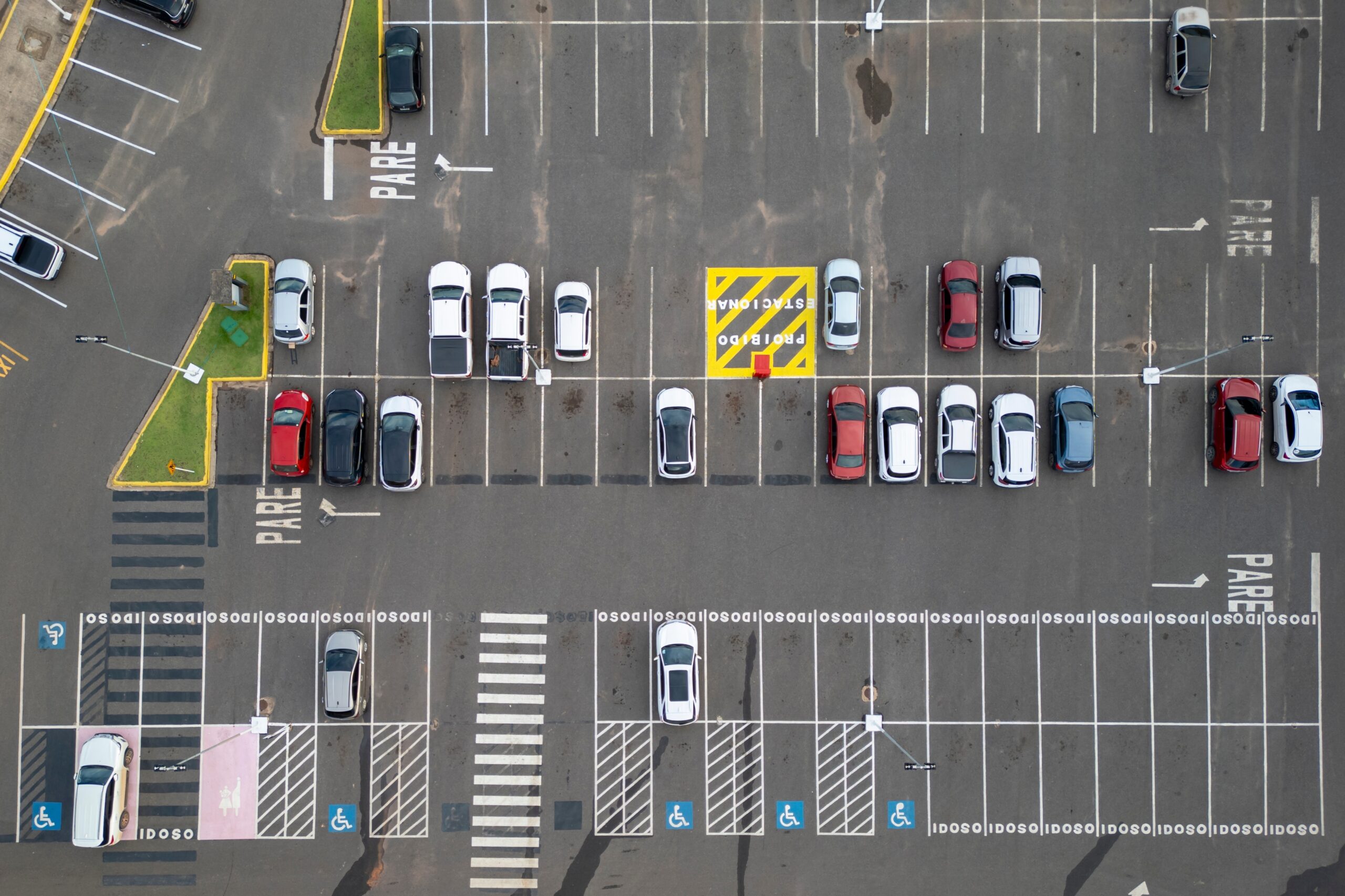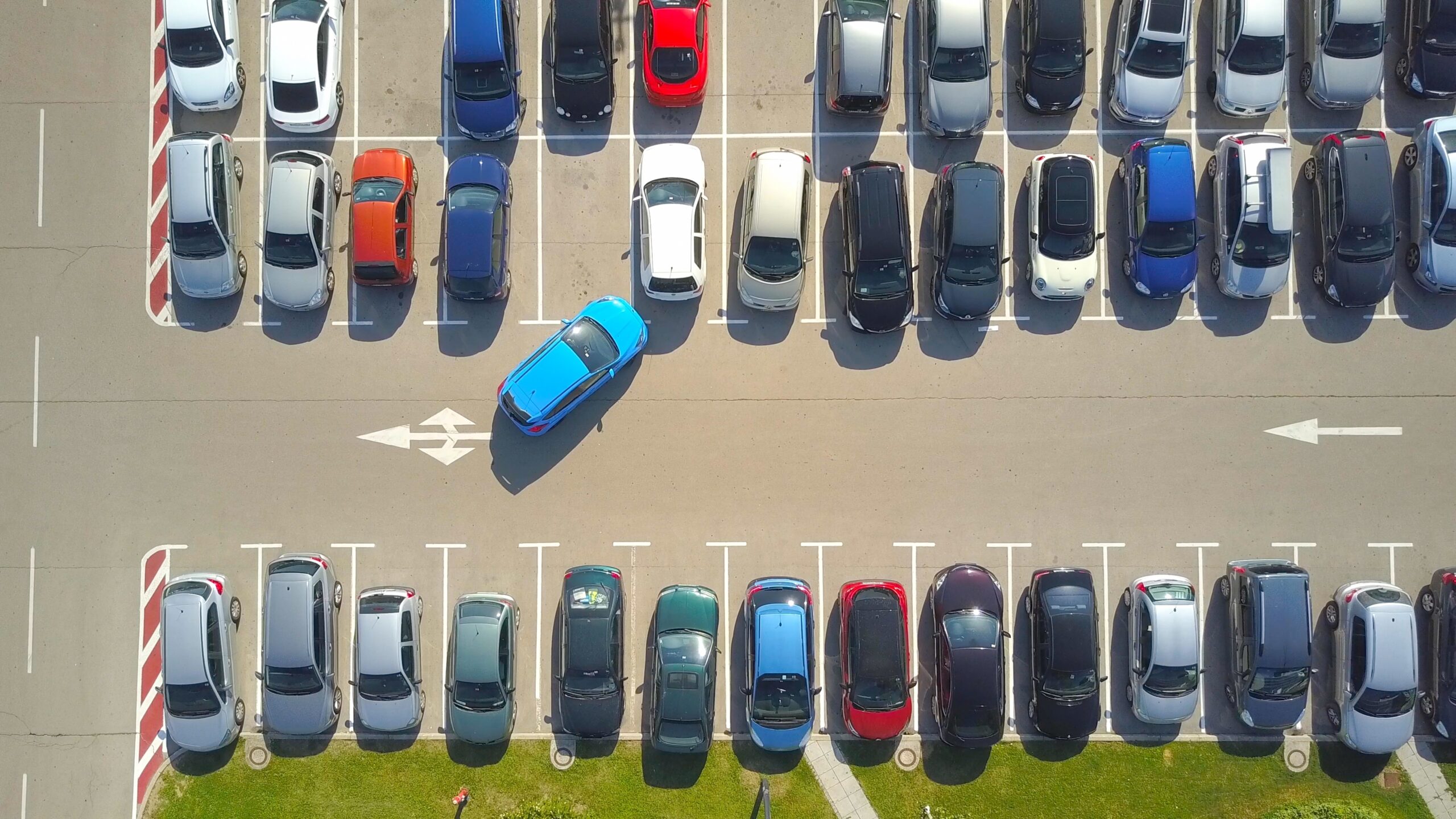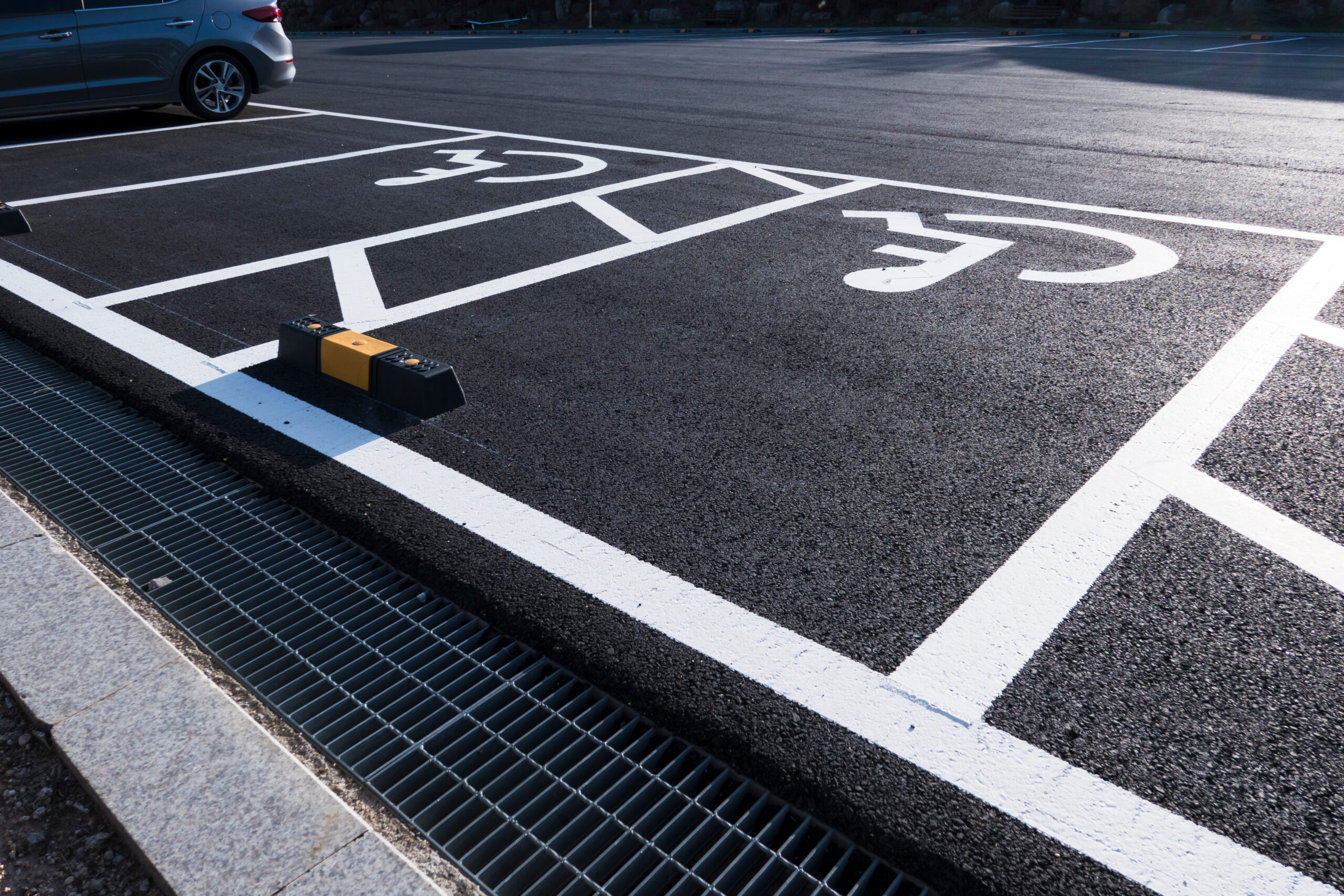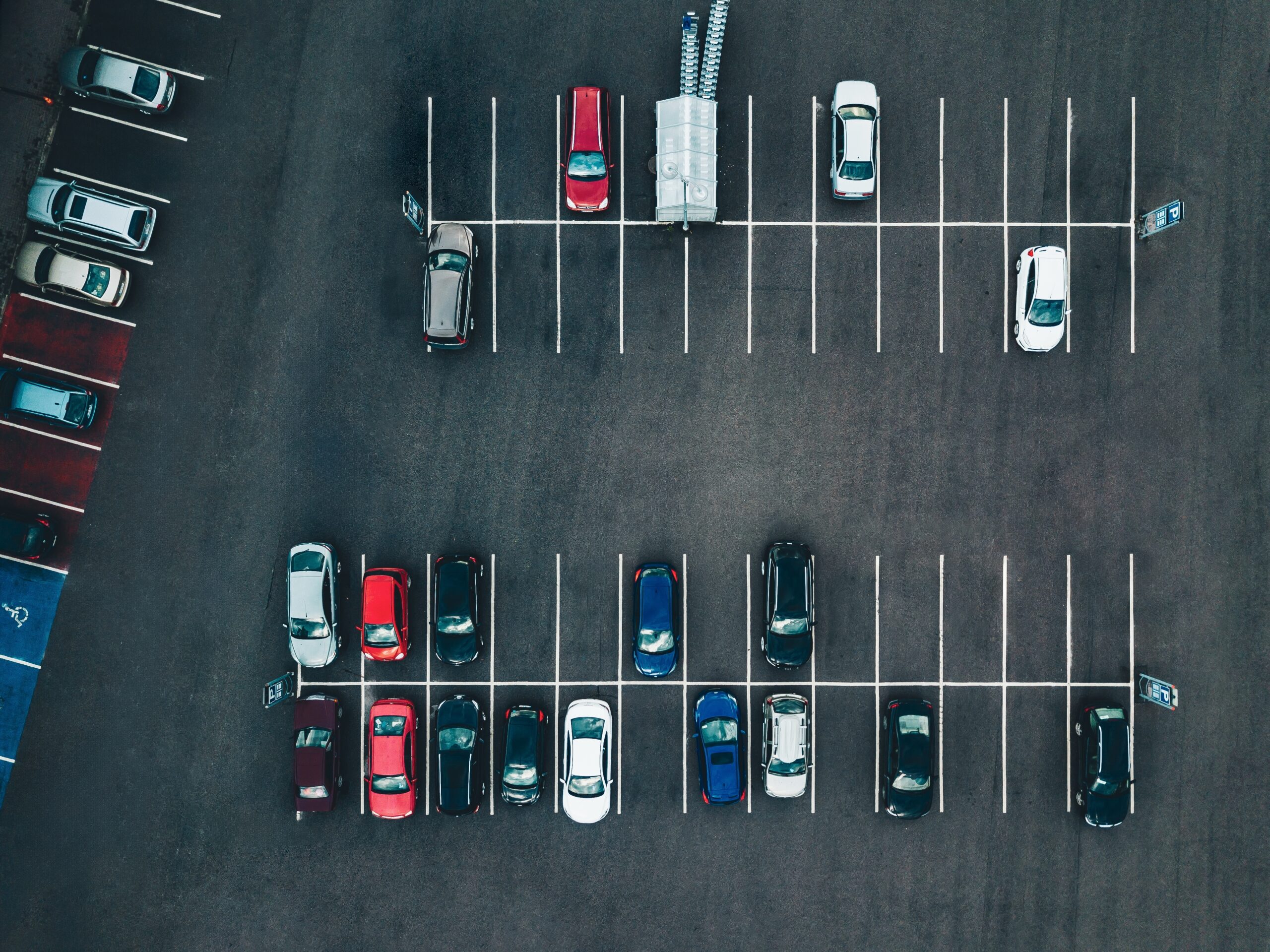Driving or walking through a parking lot or along a private roadway at night can be stressful. Faded lines, poor lighting, and wet surfaces all contribute to confusion and increased risk of accidents. That is why reflective striping is more than just paint on pavement; it is a safety feature that saves lives. For example, Portland’s Vision Zero program found 1,529 lane-departure crashes during low-light conditions between 2016 and 2020, resulting in 36 deaths and 134 serious injuries, and the Oregon Department of Transportation reports that reflective pavement markings can reduce nighttime crashes by about fifteen percent.

In this article, we examine the importance of clear striping, discuss materials and technologies, and explain how proper markings safeguard drivers and pedestrians while meeting legal requirements.
Why Night-Time Visibility Matters
As night falls, the risks and responsibilities for drivers, pedestrians, and property managers grow dramatically. Visibility becomes the defining factor between safety and uncertainty, and that’s where the proper striping steps up. According to the National Highway Traffic Safety Administration, about 49% of passenger-vehicle occupant fatalities occur at night, even though only ~25% of travel happens then, making nighttime driving nearly three times more dangerous per mile. Retroreflective markings help close that gap.
The Higher Risk of Nighttime Travel
Nighttime brings out hazards that are not present during daylight. Drivers face reduced depth perception and compromised peripheral vision, making it more difficult to gauge distances, recognize boundaries, and react promptly. Additionally, the glare from headlights or reflections on wet pavement can easily obscure faded or missing striping.
The Impact of Clear Striping
When striping is crisp and reflective, it provides immediate visual cues that help drivers maintain their lanes, recognize crosswalks, and avoid confusion, especially in unfamiliar lots or on winding roadways. For pedestrians, visible markings offer safe passage and assurance that their route is protected, even after dark.
Emotional Comfort and Safety
Good striping doesn’t just prevent crashes; it also enhances safety. It creates an atmosphere of order, comfort, and confidence. Drivers are less anxious, pedestrians know where to walk, and property owners can rest assured that they’ve done their part to keep everyone secure.
How much difference does night-visible striping really make compared to regular paint?
Night-visible, retroreflective striping stands out under headlights, while standard paint can virtually disappear after dark or in poor weather. The difference is immediate and noticeable; drivers and pedestrians respond more confidently, and safety improves for everyone on your property.
Common Challenges After Darkness Falls
Even a property that feels well-organized during the day can turn challenging after sundown. In wet-night conditions, many traditional markings lose much, or all, of their retroreflectivity, a finding confirmed by FHWA studies, making lanes harder to perceive and increasing run-off-road risk. Let’s take a closer look at why low-light conditions demand so much from your pavement markings.
Hazards of Faded Striping
Worn-out or barely-there markings can lead to confusion at intersections and in parking areas. Drivers may park incorrectly, block access lanes, or encroach on walkways, while pedestrians struggle to identify crosswalks or safe zones. These “confusion zones” quickly become hot spots for near-misses or even accidents.
The Compounding Effects of Weather
Rain and fog not only reduce general visibility but also exacerbate the weaknesses of faded or poorly maintained striping. Wet pavement can create glare that completely obscures lines, while low contrast makes it difficult to distinguish lanes and boundaries.
Security and Liability Risks
Properties lacking visible striping are more difficult to patrol, and security cameras may struggle to capture activity in poorly defined areas. The risks aren’t just about physical safety; property owners face increased liability for accidents and can be seen as inattentive to basic standards.
What are the most common problems property managers see at night due to poor striping?
Managers often report drivers parking outside lines, blocking fire lanes, and having difficulty enforcing accessible spaces or walkways. Pedestrians may cross in unsafe places, and property security is weakened due to hard-to-monitor boundaries.
How Reflective Striping Works, Basics
The true advantage of modern striping lies in retroreflection, the process by which glass beads in pavement markings send headlights’ light directly back to its source. According to FHWA research, this effect makes painted lines appear illuminated at night, dramatically improving visibility. Here’s what sets today’s best practices apart from the paints of the past.
The Science Behind Retroreflectivity
Reflective striping relies on the use of glass beads embedded within specialized traffic paints or thermoplastics. These beads are engineered to bounce light from car headlights directly back toward the source, creating lines that appear to “light up” at night.
Material Innovations for Maximum Visibility
Thermoplastic striping and advanced reflective paints offer greater durability and visibility compared to older products. These materials are formulated to withstand harsh weather and heavy traffic, ensuring the lines remain bright and easy to see for years, not just a few months.
Why It Matters for Every Property
Any location that welcomes vehicles or foot traffic after dark benefits from retroreflective striping. From busy retail lots to private driveways, enhanced visibility helps everyone, from delivery drivers to visiting families, move safely and confidently at night.
Can reflective striping really make a difference if my property already has good lighting?
Absolutely. Even with great lighting, reflective striping amplifies visibility and provides guidance in areas where shadows or weather might otherwise obscure markings. It’s a layered safety solution that works in tandem with lighting for the best results.
Striping That Works, Evidence and Impact
Choosing the proper striping is more than just a cosmetic decision. It has real-world, measurable benefits for safety, traffic flow, and property value.
Reduced Nighttime Accidents
Well-maintained, highly visible striping significantly decreases the risk of vehicle collisions, pedestrian injuries, and property damage after dark. Data show that wet-weather pavement markings reduced wet-night crashes by approximately 32% and wet-night fatal injury crashes by about 49%, with dry-night crashes decreasing by around 10%. FHWA research confirms that retroreflective upgrades enhance nighttime visibility and lower crash risk, and a 2024 peer-reviewed study demonstrates that wider lines significantly improve marking visibility under low retroreflectivity conditions.
Clearer Parking and Traffic Flow
Defined parking stalls, fire lanes, and pedestrian walkways make life easier for everyone. Drivers can park confidently, emergency routes remain open, and visitors never have to guess where to walk or drive.
Reputation and Compliance
Properties with sharp, visible striping give the impression of careful management and attention to safety. This doesn’t just boost your curb appeal; it helps with compliance, reduces liability, and can even contribute to lower insurance premiums.
How often should I assess the effectiveness of the striping on my property?
A yearly review is recommended for most properties, and you should always inspect after sealcoating, significant repairs, or noticeable fading. For high-traffic areas, consider more frequent checks, especially before and after winter.
Striping With Added Security Value
A property’s security doesn’t end at the fence or the front door. For this section, let’s focus on the key security benefits with a simple dotted format:
- Establishes clear property boundaries, deterring unauthorized access or loitering.
- Enhances the effectiveness of security patrols by making routes and restricted areas unmistakable.
- Improves surveillance footage; high-contrast lines help cameras capture incidents clearly.
- Directs vehicles and pedestrians along designated paths, thereby reducing the likelihood of accidents or trespassing.
- Supports emergency responders by highlighting fire lanes, exits, and access points at a glance.
According to the Research, visible boundaries and pathways strengthen territorial reinforcement and natural surveillance. A randomized trial in New York City also found that improved nighttime lighting reduced outdoor index crimes by about 36%, underscoring how clear markings and good lighting together can enhance property security.
Does reflective striping truly enhance the effectiveness of my security system?
Yes. Security cameras perform best when property boundaries and pathways are well defined. Bright, reflective striping provides clear reference points for surveillance, making it easier to identify unauthorized activity, even in low-light conditions or during video review.
Choosing the Right Paint and Materials

Selecting the right striping materials is a long-term investment in safety, appearance, and property value. Here’s what every property owner should know when making this crucial decision.
Reflective Traffic Paint
Reflective traffic paint remains a favorite for many property owners seeking a strong balance of performance and cost. Infused with retroreflective glass beads, this paint provides excellent night-time visibility and dries quickly, making it a flexible option for busy lots or tight project timelines. It’s ideal for parking stalls, crosswalks, and driveways. The main trade-off is maintenance; over time, heavy use and snow removal will require periodic touch-ups to maintain maximum visibility.
Thermoplastic Striping
Thermoplastic offers unmatched durability and reflectivity, especially for properties that see heavy traffic or require high standards for night-time safety. Applied hot, this material bonds with the pavement and resists wear from vehicles, chemicals, and weather better than most paints. While the upfront investment is higher, thermoplastic lines last for years, often outlasting several cycles of regular paint. For intersections, busy entrances, or industrial yards, thermoplastic delivers long-term savings and superior performance.
Standard Traffic Paint
Standard traffic paint offers a cost-effective solution for less demanding environments or temporary striping requirements. While quick to apply and available in a range of colors, standard paint doesn’t provide the same level of retroreflectivity or longevity as its higher-end counterparts. It works well for areas with minimal night traffic, but for any lot where safety and security are a concern after dark, investing in reflective options is well worth it.
Surface Preparation and Application
No material can perform well if applied over dirty, oily, or damaged pavement. Professional contractors ensure the surface is thoroughly prepped, dry, and clean, optimizing adhesion and maximizing lifespan. The expertise and equipment of a professional also ensure precise line placement, correct thickness, and uniform bead distribution, all of which are essential for durability and visibility.
The Importance of Professional Guidance
With numerous options and site variables, such as climate, traffic volume, and compliance requirements, it pays to have a knowledgeable contractor assess your property. At Asphalt Coatings Company, our team helps match the right materials to your unique requirements, balancing budget, durability, and the highest safety standards.
What’s the most cost-effective striping material for Colorado properties?
For long-term savings in high-traffic or harsh weather conditions, thermoplastic is often the best choice. For most commercial parking lots maintenance, reflective traffic paint strikes a balance between cost and visibility. A professional assessment takes all your needs into account for the best return on investment.
Planning and Maintenance for Long-Term Results
Getting your striping right is only the beginning. Maintaining visibility and effectiveness over the years requires a proactive and professional approach. This is where maintenance planning pays off in safety, appearance, and compliance.
Inspection Schedules and Triggers
Establishing a routine for inspections is the foundation of adequate maintenance. According to the Federal Highway Administration, markings should be maintained using recognized methods, such as nighttime visual inspection, measured retroreflectivity, or service-life scheduling, to ensure they remain above MUTCD minimums. That’s why most property managers schedule annual reviews, with additional checks conducted after winter, storms, or any major property work, such as sealcoating or resurfacing.
Timelines for Re-Striping
The life expectancy of your striping depends on the material, traffic, and weather conditions. Most lots benefit from re-striping every one to three years. High-traffic areas, main entrances, and fire lanes often require more frequent attention, while less-traveled areas can go longer between touch-ups.
Best Practices for Prolonging Striping Life
- Always use professional-grade materials matched to your climate and property needs.
- Schedule maintenance and inspections as part of your property management routine, not just when a problem is obvious.
- Work with a reliable contractor for both new applications and touch-ups; quality and expertise matter for both appearance and safety.
- Educate your staff or tenants about avoiding heavy equipment or abrasive cleaning over striping, which can cause premature wear.
Maintenance Partnership Benefits
Having a dedicated striping contractor means you get timely reminders, expert inspections, and honest recommendations. At Asphalt Coatings Company, we take pride in keeping your lines sharp, safe, and compliant for the long haul.
What’s the simplest way to know when it’s time to re-stripe my property?
If lines appear faded, patchy, or hard to spot at night, it’s time for a refresh. After sealcoating, repairs, or a harsh winter, a professional inspection ensures your property stays safe, attractive, and fully compliant.
Benefits Summary for Property Owners
Choosing high-quality, professional striping is one of the simplest ways to transform your property’s safety, security, and appearance. Here’s a quick look at what you gain:
- Enhanced Night Safety: Reduce accidents, improve traffic flow, and protect everyone on your property, drivers and pedestrians alike.
- Greater Security: Clear boundaries deter trespassing, guide patrols, and enhance the effectiveness of surveillance.
- Compliance and Peace of Mind: Stay up-to-date with ADA and local guidelines, avoid fines, and demonstrate your commitment to accessible, well-managed spaces.
- Curb Appeal: Clean, reflective lines boost the look and value of your property, leaving a lasting impression on visitors and tenants.
- Lower Liability: Fewer accidents and better maintenance documentation can lead to lower insurance costs and reduced legal risk.
How do I know if my property’s striping is still delivering all these benefits?
Regular professional inspections and honest self-assessment at night are the best ways to gauge the effectiveness of your striping. If visibility, order, or security are compromised, it’s time for an upgrade.
Nighttime Safety and Security Start With the Right Striping

Taking your property’s safety and security to the next level starts with something as simple as the lines you paint on your pavement. Reflective striping, regular maintenance, and professional planning don’t just tick compliance boxes; they protect people, assets, and reputations. Asphalt Coatings Company has helped property owners across Colorado make smart, cost-effective decisions about their pavement markings for decades.
Ready to make your property safer and more secure after dark? Contact Asphalt Coatings Company today to receive a complimentary, expert quote and discover the difference professional striping can make.
Frequently asked questions
How often should parking lot striping be repainted?
Most commercial lots require fresh striping every two to three years, depending on traffic volume, climate, and the type of material used. Regular inspections will reveal when lines start to fade or lose reflectivity.
Does retroreflective paint work in wet conditions?
Standard traffic paints lose reflectivity when covered by water, but specialized wet-night visible materials and thermoplastic with embedded glass beads maintain visibility during rain. A contractor can recommend the right product based on your climate.
Are there environmentally friendly striping options?
Yes. Low-VOC water-based paints and MMA coatings offer durability with reduced environmental impact. Advances in bead technology also reduce microplastic runoff.
Can striping alone deter crime?
Striping contributes to crime prevention when combined with adequate lighting, surveillance, and maintenance. Research shows that well-illuminated environments with clear markings experience significantly lower crime rates.
What should I look for in a striping contractor?
Choose a contractor with experience in commercial projects, knowledge of MUTCD standards, and the ability to recommend appropriate materials. Ask for references and evidence of compliance with local regulations.



